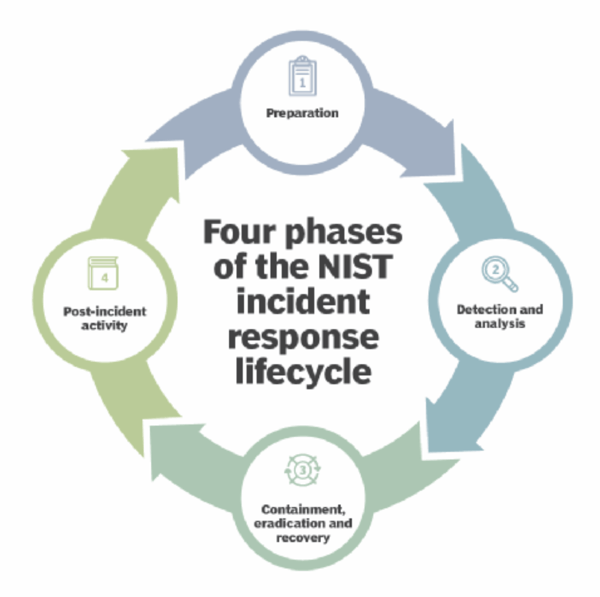December 21, 2023
 by Nadica Metuleva / December 21, 2023
by Nadica Metuleva / December 21, 2023

If we are to pinpoint a fight without an end or a definite winner, that would be the fight between cybersecurity experts and cybercriminals.
This is a never-ending challenge.
As technology advances, criminals who seek to exploit vulnerabilities are becoming more creative. On the other side, organizations are becoming more wary - and capable of staying ahead of the ever-changing digital threats.
Without a proactive approach, a single attack can cause your business to halt its operations - or even cause its failure. We are talking about a fortune in fines, business revenue, and legal fees, not to mention the mark this can leave on a brand’s reputation.
The risks today are big, more numerous, and more versatile than ever. To protect your business and stay ahead, you need a proactive approach to cybersecurity and a robust resilience strategy.
In this post, we’ll teach you why this matters and how you can achieve it.
A ransomware attack takes place every 40 seconds today.
On average, cybercriminals create 1.4 million websites for phishing per month, most of which contain pages that mimic a real company - such as yours.
So, we are looking at around 2,200 estimated cyber attacks every single day! What does this tell us?
This goes to show that digital threats are here, and they are more numerous and successful than ever. Today, when most businesses need technology to progress and succeed in the market, cybercrime is one of the biggest threats to their success.
The consequences of a digital attack can vary from minor to devastating for a business. If you are hacked, your company’s information and that of your customers can end up in the wrong hands.
You can get into legal trouble and pay legal fees that can cost billions! Not to mention, depending on the attack and its success, this can turn a very successful business into ash.
It also depends on the type of attack, of course. Some attacks are far more dangerous and costly than others.
Ransomware attacks, for instance, are very frequent nowadays, and these criminals have reached even the biggest brands out there.
EXAMPLE: In July 2020, GTW Global, a big US travel services company, made an enormous ransom payment - $4.5 million in Bitcoin to Ragnar Locker, a cybercrime ransomware group. The attack took down 30,000 computers and compromised tons of data, including security documentation, financial records, and employees’ personal data.
One thing is for certain: cyberattacks know no bounds, and every company can fall prey to one, or many. However, if you have an ingrained policy and take a proactive anti-fraud approach, you can mitigate many of the risks and will have a backup plan to fall on if things go wrong.
The threat landscape is shifting as technology progresses.
The threats you fought just a few years back are more versatile and advanced now, and new threats are gaining power with every passing minute.
Source: Sprintzeal
With that in mind, here are the most common types of security threats today:
Well, criminals sure love the advances in artificial intelligence (AI).
They use it more than ever. According to a report by Sapio Research and Deep Instinct, the increase in attacks in the last couple of years is mostly led by the use of AI, with 85% of attackers using generative AI.
The majority of attacks these days are facilitated by bots and other products of artificial intelligence. Cybercriminals use AI to automate everything from phishing to supply chain attacks. The good news is your organization can also implement AI for cybersecurity measures.
Ransomware attacks these days are more targeted and, therefore, more destructive. Attackers now encrypt data and demand payment to keep it private.
Some of the ransomware attacks are so well-planned and executed, that they cost businesses millions. NotPetya, the biggest ransomware attack to date, made a monetary impact of $10 billion and impacted major companies.
When cyber criminals target your company’s supply chain, they are performing a supply chain attack. If they are successful, they can completely infiltrate your network, and you won’t even notice it until it’s too late.
In this case, criminals infiltrate trusted vendors and use them to compromise the software and reach the end users. The potential damage has no limits.
Phishing has been around for a long time, and it remains one of the main ways criminals take over websites. In this case, the hacker will send a deceptive message disguised as an email from a real entity, requesting that the recipient reveal their login details.
In other words, they can pretend it is your company sending a message to a customer or an employee, demanding their login details or payment information. With the data on hand, they can use it to log in and do their damage.
According to Statista, 76% of businesses have reported being a victim of such an attack in 2022 alone.
Source: Statista
Distributed denial of service (DDoS) attacks occur when criminals use multiple devices to hit a server with fake traffic. The result? The website becomes inaccessible and cannot function normally. The attack paralyzes a server by overloading it and, in many cases, makes a website go offline.
This can be devastating for big businesses with a lot of traffic since they lose during the downtime. There have been reports of major e-commerce platforms suffering such downtimes, even in the busiest periods.
Similarly, SQL injections allow hackers to access your data and shut it down. They inject SQL commands into existing scripts, and when they succeed, they can execute a variety of commands - including shutting it down altogether.
Source: Spiceworks
Malware attacks have been around for the longest time, but they remain one of the most common cyberattacks on the wide web. Malware is malicious software or virus designed to somehow harm your computers, servers, networks, or clients.
In fact, any type of malicious software that serves the purpose of harming or exploiting a programmable network or device falls under the “malware” category.
While digital threats now come attached to the use of technology and the internet, and eliminating them altogether is impossible, there are some measures you can take to prevent, detect, and mitigate them.
More specifically, you need what we call a cyber resilience strategy - and here is how to create it.
The rule of thumb in cyber security is to prevent it when possible. It’s always better and cheaper to prevent a threat than it is to fix the damage.
So, start by securing your data.
If your data isn’t as secure as it can be, this is the perfect time to opt for a safer option. Start by transferring data and resources to a safer infrastructure or a different software i.e., perform a system migration. Just ensure you optimize the system migration process and keep it as safe as possible.
Next, it is time to back up all the data. This is part of your recovery plan - you have another location for the important information in case it gets lost, or your business falls victim to a cyber attack.
Data backup is regular work - not a one-time measure. Regularly back up systems and critical data using a variety of solutions such as external hard disks and cloud-based software.
Data protection laws change every day.
They regulate millions of businesses in order to protect customers. In case of a data breach or any other cyber attack, you must make sure that your business is compliant with current regulations to avoid hefty legal fees and problems.
While there are plenty of ways to adhere to the changing data privacy laws’ requirements, some practices are more popular than others, such as the use of the banner cookie.
Cookie banners are a way to meet the requirements unobtrusively. They appear as a pop-up when people visit your website, informing them about the use of cookies and asking them for consent.
When the visitor accepts the cookies and the storage and use of their data, you are legally covered. It is still your responsibility to protect that data but if a breach occurs and you’ve taken the necessary measures to prevent it, you at least won’t have to think about legal consequences.
Backing up data is just step one of your recovery plan. In many cases, it won’t matter if you have the data stored somewhere else if it is already compromised.
So, how can you create an incident response plan?
Simply put, a cyber incident response plan is a document, a plan that outlines what your company would do in the event of a security incident such as a data breach.
Many of the cyber attacks are unavoidable, even if you have an excellent protection system in place. However, such a plan will give you something to work on - an action plan, if you’d like.
The response plan will have guidelines for your organization to take before an incident occurs. Then, it will contain steps that it needs to take to identify when the systems or data are compromised.
Next, it will give you ideas on how you can mitigate the damage if and when it occurs. And finally, it will give you a plan on how to recover from different types of cyber attacks. 
Source: TechTarget
Cyber threats are best dealt with when you catch them in real time. However, with so many threats and attempts, it is impossible to keep track of everything - and notice every little glitch that indicates an attack.
Businesses and cybersecurity professionals have a great set of tools at their disposal for real-time threat detection. Most of the threats are avoidable if you catch them before they penetrate your security system, and tools like web proxies and bot detection can help you do this non-stop, without any human effort.
You can test and evaluate your digital presence and data by using monitoring and assessment tools and services. These will automatically conduct vulnerability assessments, penetration testing, and security audits to address any vulnerabilities in your business’s digital products, such as a website or an app.
Did you know that 88% of data breach incidents are caused by an employee who made a mistake?
Unless you train your employees and teach them how to fight off digital threats, your business is at harm. It doesn’t matter how great of a software you’ve invested in to track and mitigate attacks or how thorough your recovery plan is - a single employee can leave the virtual door open for hackers, often unintentionally.
This is why, today, more than ever, it is important to educate your staff on common digital threats, how to identify them, and how to respond to them. Think of your employees as the first line of defense you have against cyber criminals. It is your responsibility to educate them on the topic to prevent hackers from using your team to harm the business.
While collecting and using user data is covered with consent, it is still your responsibility to encrypt that data and keep it safe. Strategies like encryption defend sensitive information against cyber attacks and brute force attacks like ransomware and malware.
Simply put, you’d be translating all sensitive data into code or another form so that only the people who can read it will be able to access it.
Cyber resilience is a work in progress.
You can’t simply create an incident response or recovery plan, invest in some software solutions, and forget about the matter.
Criminals are more creative with every passing day, which means that the strategies you use today might no longer work tomorrow. With that in mind, you should regularly review and update your strategy to align with new digital threats and the industry’s best practices.
When you take measures to detect, prevent, and mitigate cyber threats, you are forming your cyber resilience strategy. Here are some of the reasons why this is important:
A good strategy protects your organization against digital threats. It includes everything from backing up the data, addressing vulnerabilities, and preparing for any potential cyber attacks.
Even though digital threats are more numerous than ever - and far more dangerous than before, most businesses operate on the premise that they are too small for cybercriminals to target them or that their old strategies worked so far, so why wouldn’t they now?
This means that most of your competition will have outdated or poor cyber resilience strategies in place - if any. According to an UpCity poll, 50% of businesses don’t have a cybersecurity plan at all.
This gives you an excellent competitive advantage. For starters, you are less likely to become a victim of a cyber attack. But you can also show the target audience that you are dedicated to robust practices and position yourself as a more reliable, trustworthy partner.
A strong cyber resilience program safeguards the reputation of your business. If you do this continuously, it will foster trust among your customers, as well as your partners and stakeholders.
A stronger reputation in a competitive market is everything. It equals more customers, stronger partnerships, and, of course, more profits.
As we mentioned, law compliance is very important when it comes to data protection and privacy, and if you fail to remain compliant, you are looking not only at data leaks and hacks but at penalties and legal problems, too.
Your cyber resilience program should be focused on industry regulations and standards above everything else to ensure that, at any given moment and in any scenario, your business is compliant with the current laws.
The cost of being non-compliant is nearly three times higher than the cost of being compliant these days. On average, the cost of compliance is $5.47 million compared to $14.82 million for non-compliance.
Source: Fortra
While not all cyber attacks are avoidable, a good security plan and strategies can help you avoid most of them. For any digital threat you successfully prevent or mitigate, you are ensuring business continuity and success.
Let’s say that you manage to protect your business from a ransomware attack that would otherwise cost you millions - or ruin it altogether. You just helped your business survive. Let’s say you avoided endless phishing attacks or malware trying to get to your data. Congratulations, you’ve successfully safeguarded your financial stability and your reputation.
If you prevent a DDoS attack or an SQL injection, you can maintain a seamless workflow and prevent major losses.
Today, not taking your business online is a big disadvantage. In fact, in most cases, businesses must go online to reach their targeted audience and make sales. However, with this advantage come many risks, most of them in the form of digital threats.
Digital threats are everywhere - and it is your responsibility to protect your business. It’s your task to create a fierce cyber security resilience strategy, implement it, and keep it constantly updated.
Digital threats evolve and change more frequently than anyone can follow. That being said, it’s your job to keep up with the changes in cybercrime as well as cybersecurity strategies. To be one step ahead, you definitely want to consider predictive trends and imminent risks, especially with the growing popularity of AI and remote work.
Artificial intelligence and machine learning give cybercriminals a plethora of options when it comes to targeting businesses.
No matter how big or small your company is, the risk is always present. Don’t think, "there’s no way they’ll bother hacking my business." This is what most of the companies that fell victim to digital attacks thought in the past!
Get a cybersecurity deep dive with Dr. Chase Cunningham as he talks about Zero Trust.
Nadica Metuleva is a senior freelance writer with 8+ years of experience in producing original, high-quality content for clients. She has a Master’s degree in English Literature and Teaching and speaks 4 languages. Nadica has a passion for storytelling and a deep understanding of SEO principles. You can find her samples and more details about her work on LinkedIn.
From personalized customer experiences to efficient supply chain management, generative AI is...
 by Carl Bleich
by Carl Bleich
Your e-commerce site looks perfect: fabulous design, meticulously crafted copy, and products...
 by Luca Montecchi
by Luca Montecchi
From personalized customer experiences to efficient supply chain management, generative AI is...
 by Carl Bleich
by Carl Bleich



